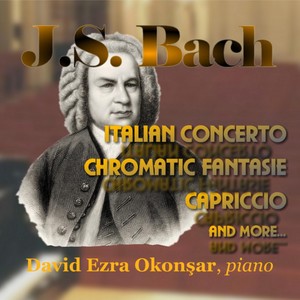
J.S. Bach Italian Concerto and More...
- 歌唱: David Ezra Okonsar
- 发行时间:2015-02-27
- 唱片公司:Lmo-Records
- 类型:录音室专辑
- 歌曲
- 时长
-
作曲家:Johann Sebastian Bach
-
作品集:Italian Concerto in F Major, BWV 971
-
作曲家:Johann Sebastian Bach( 约翰·塞巴斯蒂安·巴赫)
-
作品集:Italian Concerto in F Major, BWV 971
-
作品集:Capriccio On the Departure of a Beloved Brother in B-Flat Major
-
作品集:Fantasie and Fugue in D Minor
-
作品集:BWV 917
-
作品集:BWV 947
-
作曲家:Johann Sebastian Bach( 约翰·塞巴斯蒂安·巴赫)
-
作品集:Chromatic Fantasie and Fugue in D Minor, BWV 903
-
作品集:Fantasie and Fugue A Minor
-
作曲家:Johann Sebastian Bach( 约翰·塞巴斯蒂安·巴赫)
简介
I selected here a number of isolated pieces by J.S. Bach that I combined with the Cantor's best known pieces such are the Italian Concerto and the Chromatic Fantaisie. Even though I agree with Glenn Gould's opinion that those works (the Italian Concerto and the Chromatic Fantaisie and Fugue) "are Bach for those who do not like Bach", I can not minimize the extraordinary creativity which emerges from them, including the Capriccio. Together with the Overture in the French Style, the Italian Concerto BWV 971 makes for the second part of the Clavier-Übung published in 1735 at Nuremberg. The original title reads "Concerto in the Italian taste" Concerto nach Italienischem Gusto. It is intended to be performed on a harpsichord with two keyboards. The title page of the Goldberg Variations is the only other place where J.S. Bach specified a particular instrument for a keyboard work. The original instructions "forte" and "piano" proves the importance given by the composer to the specific instrumentation of this piece. The Capriccio on the departure of a beloved brother BWV 992 is referring to the leaving of his elder brother Johann Jacob appointed oboist to Charles XII of Sweden. J.S. Bach is then organist at Arnstadt and engaged to his cousin Maria Barbara. During the last months of 1705 he was traveling through Germany, going to Lübeck to fulfill his dearest wish: to hear the famous Dietrich Buxtehude (1637-1707) organist at Marienkirche. Back at home he will resign and relocate to Mülhausen. This charming Capriccio is composed at a time when Bach was spending endless hours copying by hand the works of great composers of his time. The famous composers of the time Bach did studied in depth were: Boehm from Germany, Marchand, Grigny, Couperin from France, Vivaldi and Albinoni from Italy. Among them one he did studied in depth and replaced on the master's death in 1723 was the Cantor of the Saint-Thomas of Leipzig: Johann Kuhnau (1660-1722). It is probable that the "Biblical Sonatas" (Biblische Historien) by Kuhnau, published in 1700, where the composer depicts with imagination and craft various scenes of the Tora ("Old Testament"), impacted on this piece. The infamous Chromatic Fantasie and Fugue BWV 903 is first published in 1802. This extremely popular piece is probably composed in Köthen between 1717 and 1723 and re-worked in Leipzig in 1730. This set is one of the works by J.S. Bach who made the strongest impact to the romantic era composers. No other composer than J.S. Bach at his time did realized a keyboard piece with such a dramatic impact. A Frescobaldi style Toccata starts the Fantasie and Fugue A minor BWV 904. In many other places, for example in the Fugue in E major of the Well-tempered Clavier II, Bach employs the "old-fashion" polyphonic style with grandeur and amazing emotional impact. The ten measures long Fantasia from the Fantasie and Fugue A minor BWV 944 is like one single phrase taken out from the Chromatic Fantasie. The indication "Arpeggio" instructs the performed to "improvise" something out of those chords by arpegiating them in many ways. Then follows one hundred ninety eight bars (typically 8 pages) long, single-themed fugue.







